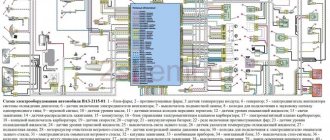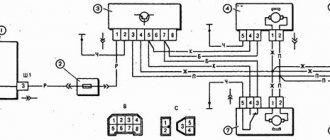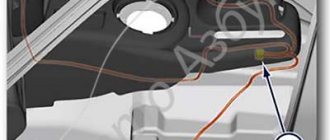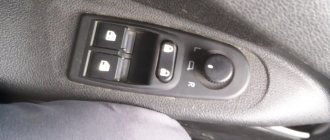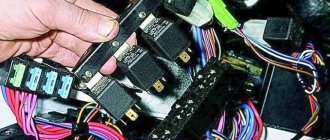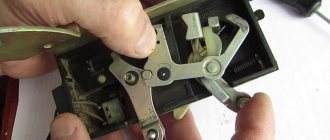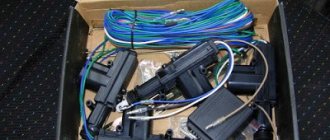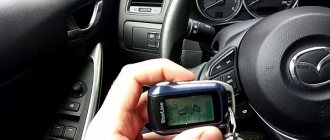Chevrolet Niva — a compact crossover of Russian assembly. Produced in 2002, 2003, 2004, 2005, 2006, 2007, 2008. In 2009, the car received a restyling. The updated version was produced in 2010, 2011, 2012, 2013, 2014, 2015, 2016, 2022 and 2018. We will look at a block with Chevrolet Niva fuses and relays with a full description of the presented circuits. Let's show you where the cigarette lighter fuse is located.
p, blockquote 1,0,0,0,0 –>
p, blockquote 2,0,0,0,0 –>
Causes of central locking malfunctions
Most often, the electrical part of the solenoids control fails , and the locks themselves are considered relatively reliable.
The central locking of a Chevy Niva car works on the following principle: the signal for opening or closing the doors is transmitted by pressing a button on the key or turning the cylinder in the driver's door, while the signal passes through the central locking control unit and the on-board computer.
This scheme has its weaknesses, and the main reasons for failure are the following factors::
Advice! If the car has an alarm system, the central locking may not open due to a malfunction of the alarm system. Perhaps the reason lies in the dead battery of the alarm control panel.
Features of programming the new signaling
Let's say the scheme discussed above was implemented without errors. At the second step, as you might guess, you need to correctly program the alarm. Otherwise, there is a possibility of burning out the actuators installed in the passenger doors. The advice is simple: you cannot make a control pulse longer than one second. However, the default value is 0.7 or 0.8.
The signal output used must also be programmed correctly (it must be activated at the moment of unlocking). An alternative method is to use the 2-step unlock output. The pulse duration on it must be set within 0.7-0.8 s. The default value is 30 s, and guess what this means in this case.
Operating principle and central locking diagram
Central locking has been installed on the VAZ 2123 since 2004 . Since then, the Chevy Niva central locking scheme has not changed fundamentally and is installed on cars starting with the “Norma” configuration. To control the remote door opening, a remote control (remote control with a flip key) is used. It combines the functions of an immobilizer, ignition key, and door key. The signal from the remote control is received by the electrical package control unit (1118-6512010), which is responsible for opening the doors.
Pressing a button on the remote control opens or closes all car doors , including the trunk door. In the same way, the central locking is triggered when the key in the driver's door is turned half a turn to the right or left.
The operation of the electrical network is controlled by a standard relay type 90.3747 , a 20 A fuse, limit switches in each door, and gearmotors on the lock mechanisms.
A special feature of the Chevrolet Niva Central Locker is the ability to manually open and close the doors, even with the battery removed.
Important! The gearmotors are equipped with protection against overheating and turn off for a while after repeated activation of the central locking system.
First stage
Removing door panels.
First you need to remove the door trim and dust curtains from each door. Before doing this, you should disconnect the terminals from the battery for your own safety.
Removing the door panels is a fairly simple task - unscrew the 4 screws under the shelf. Now you need to remove the handle. Then you can carefully remove the upholstery. Think about the three latches located on the edge of the lock. The door has a plastic screw that needs to be unscrewed. Then remove the screws located in the trim under the steering wheel (the first on the left and the other on the right side).
Selecting a location for installation.
To choose a suitable location for the central locking for installation, you need to take into account the location of the insides of the window regulators. It is possible that you will need to make a separate bracket for mounting. Experienced craftsmen suggest that the lower left corner is the best place for installation, because when lowering the glass, the latter will not touch the lock and interfere with its operation.
Installation of the activator.
Lock activators are installed separately on each door. To do this, you need to drill additional holes and secure them with self-tapping screws. We do the same installation for each door.
Attaching the activator to the lock rod.
Each activator from the installation kit must be secured to the door with clamps. Very often, the central lock has a large force that the activator must apply to open the door. Since the stroke of the actuator rod is greater than that of the lock rod, it is necessary to align the center of the stroke of both rods.
Further from the activators, we install clamps on the rods of the manual lock block. This work must be done with each individual car door. When connecting actuators, you need to check the wiring for current conductivity.
If the hole in the central locking rod is larger than necessary, you can use a plastic bushing that will reduce its size to the required size.
Ways to solve problems with central locking Niva Chevrolet
Before starting work, it is recommended to evaluate your repair skills and experience with electrical wiring in a car. Special equipment may be required, and at a minimum, a tester is required to diagnose electrical circuits. Troubleshooting always starts from simple to complex.
Fuse failure
The fuse is the first thing every car enthusiast should check if the central locking stops working . The symptom will be the failure of all doors to close with the button at the same time. It's easy to check - just open the mounting block and replace it with a serviceable one of the same rating.
Most often, the cause of its burnout is a short circuit or overload in the circuit . In the mounting block of cars manufactured before 2009, it is designated F6; on cars after 2010, it is located under the number F10.
Gearmotors
Their breakdown does not occur often, but repairing or replacing motors in doors requires partial disassembly of the door and removal of the upholstery . A faulty motor can be detected by the silence on its part when the central locking system is activated or incorrect operation (does not open completely, fires every other time, extraneous sounds).
Functionality is checked with a multimeter or by connecting to the battery directly. Replace the gearmotors with a new assembly if the old one cannot be repaired.
Advice! It happens that the sounds of the motor operating are heard, but the door does not respond to signals from the key. In this case, it is necessary to check the rods coming from the locks to the gearmotors and door handles.
Wiring
This is probably the weakest point in the entire electrical circuit of the central locking system . The problem is that the door is a moving element, so the wiring harnesses are constantly being twisted in these places.
In addition to the central locking system, alarm wires, limit switches, audio systems, and power windows enter the door. Despite the rational S-shaped bend of the door wiring in the corrugation, damage to one or more wires occurs. The second weak point is the contacts inside the door.
The integrity of the wiring is checked by “ringing” suspicious sections of the circuit . The found break is cleaned and connected by soldering or crimping bushings. Replacing a broken wire entirely with a new one is not always advisable due to the complexity of the work.
Relay circuit
Power to the central locking can be supplied through the main relay used for low beam headlights and interior lighting. There are also schemes with a separate relay for the central locking, which is installed next to the control unit of the door opening system.
Purpose of the mounting block
The Chevrolet Niva mounting block combines a fuse and relay panel. To get to it, you need to unscrew the screws securing the cover under the steering column, and then pull this cover towards you. The purpose of the mounting block elements depends on the year of manufacture of a particular model. In 2009, the Chevrolet Niva underwent restyling, therefore, along with other changes, the functions of the protective devices also changed.
Fuse box before 2009
In 2009, changes were made not so much to the appearance of the panel as to the purpose of the fuses. In models produced before restyling, the relative arrangement of all electrical elements was as follows:
Each protective device ensures the integrity of a separate circuit consisting of one or more consumers.
| Fuse |
(current strength, A)
Fuse box after 2009
Since 2009, the appearance of the mounting block and the relative position of all its components on it have changed. The appearance of the relays and their purpose have changed.
The purpose of the protective elements installed in the same position has also changed.
| Protected Circuits | |
| F1 (5 A) | Backlight lamps. Trunk light. Engine compartment lamp. License plate lamps. Front marker lamps |
| F2 (7.5 A) | Low beam lamp (left headlight). Electric headlight corrector. Corrector motor gearbox |
| F3 (10 A) | High beam lamp (left headlight) |
| F4 (10 A) | Left fog lamp |
| F5 (30 A) | Power window relay. Electric windows |
| F6 (15 A) | Electric door lock control unit |
| F7 (20 A) | Cigarette lighter. Horn relay. Sound signal |
| F8 (20 A) | Rear window heating relay (contacts). Rear window heating element |
| F9 (20 A) | Glove box lighting lamp. Windshield wiper relay. Windshield wiper switch. Windshield wiper motor. Headlight wiper relay (contacts). Electric motors for headlight cleaners. Headlight washer motor |
| F10 | Reserve |
| F11 (5 A) | Rear position lamp. Instrument lighting control |
| F12 (7.5 A) | Low beam lamp (right headlight). Corrector motor gearbox (right headlight) |
| F13 (10 A) | High beam lamp (right headlight) |
| F14 (10 A) | Right fog lamp |
| F15 (20 A) | Exterior mirror control unit. Exterior mirror control motors |
| F16 (10 A) | Relay-breaker for direction indicators and hazard warning lights (in hazard warning mode) |
| F17 (7.5 A) | Individual lighting lamp. Immobilizer warning lamp. Brake light bulbs. Additional brake signal. Interior lighting |
| F18 (25 A) | Reversing lamps. Electric heater fan. Windshield washer motor. Rear window heating relay (winding). Rear window wiper relay. Rear window wiper motor. Rear window washer motor. Door lock control unit |
| F19 (10 A) | Relay-breaker for direction indicators and hazard warning lights (in direction indication mode). Devices. Differential lock indicator lamp |
| F20 | Rear fog lights |
| Fuse (current, A) | Protected Circuits |
| F1 (5 A) | License plate lights, side light lamps in the left headlight and left rear light, engine compartment lamp, side light indicator lamp |
| F2 (7.5 A) | Low beam lamp (left headlight) |
| F3 (10 A) | High beam lamp (left headlight), high beam indicator lamp |
| F4 (10 A) | Left fog lamp |
| F5 (30 A) | Power window relay, front power windows |
| F6 (15 A) | Cigarette lighter |
| F7 (20 A) | Horn Relay, Horn, Trunk Lamp |
| F8 (25 A) | Heated tailgate glass element, heated tailgate glass relay, heated outside rear view mirror elements |
| F9 (20 A) | Heated tailgate switch, windshield wiper relay, windshield wiper motor, windshield washer pump, right steering column switch, glove compartment lamp, reverse lamps |
| F10 (20 A) | Remote control unit for electrical accessories (door locking) |
| F11 (5 A) | Side light lamps in the right headlight and right rear lamp, instrument lighting brightness control |
| F12 (7.5 A) | Low beam lamp (right headlight), gear motors for headlight beam control |
| F13 (10 A) | High beam lamp (right headlight) |
| F14 (10 A) | Right fog lamp |
| F15 (20 A) | Outside mirror control unit, electric outside rear view mirrors, heated seat control unit |
| F16 (10 A) | Relay-breaker for direction indicators and hazard warning lights (in hazard warning mode) |
| F17 (7.5 A) | Interior lamps, anti-theft system status warning lamp, brake lights, additional brake light |
| F18 (25 A) | Heater fan |
| F19 (10 A) | Relay-interrupter for direction indicators and hazard warning lights (in turn signal mode), instrument cluster (except for engine management system malfunction warning lamp), starter relay |
| F20 (7.5 A) | Fog lamps in the rear lights, anti-theft control unit, buzzer |
Where to look for a fault
Mechanical failures are the least likely to occur. This usually happens in winter, when moisture that gets into the locking mechanisms freezes, which creates an obstacle to opening or closing the car doors. This problem is solved after warming up the mechanisms. True, sometimes difficulties will arise with such an operation, especially when the door needs to be opened. To detect faults in electrical circuits, you will need a car tester or other similar measuring device, as well as skill in working with electrical equipment of cars.
First of all, you should check the serviceability of fuse F10, which is rated for a current of 20 Amps. Indirect confirmation of his refusal will be the inability to close the doors using a key fob or car key. If the fuse is faulty, it should be replaced with a good one, but check why it failed. In the event that there is a short circuit in the circuit, re-blowing of the fuse is guaranteed.
Tips for motorists
Such a malfunction is “not fatal” for the car, but very unpleasant. Unfortunately, this problem occurs on this model. The problem can be either serious or not so serious, which you can easily fix yourself. That's what we'll talk about in this article. Malfunctions can be in the mechanical part, as well as in the electrical equipment of this system.
What else could go wrong?
The cause of the failure may be a breakdown of the electric motor in the door lock drive. It practically never happens that the engines in all the doors “burn out” at the same time. The drive motor is checked with a measuring device; to do this, it is necessary to measure the resistance of its windings. Also pay attention to the condition of the connector contacts with the wires.
Due to a malfunction of the motor in the driver's door, the entire door locking system will fail. You should also check the supply voltage to the connectors with the electric motor wires, as breaks occur in these circuits. There may be a failure of the mechanical locking of one of the doors. In this case, you should disassemble the upholstery of the non-working door and carefully inspect the locking drive mechanism. Most often, the drive jams. Sometimes installing an alarm yourself can lead to blocking failure, so you should entrust this work to specialists.
Hi all! As usual, I closed the doors with the button, and the next day the driver's side opened, but the others don't open, I don't even know how to get into the trunk? Has anyone encountered this? I will be very grateful for the advice! They say that the limit switch is located inside the drive?
What are the responses to deviations?
Sometimes the standard Niva alarm system does not connect even when the door locks are closed. Then you need to open switch “3” with key “2”. But the switch is located in a glove-type box. In addition, it turns out that the emergency flashlights of the anti-theft system do not turn on when it is connected.
This indicates that the trunk lid, hood, or some other door has opened, and at the same time, the perimeter control function is disabled. In such a case, it is necessary to tightly close the doors and much more. Then the hazard lights will turn on, indicating that the data monitoring mode is activated.
When the Chevrolet alarm battery is completely discharged, it is characterized by continuous operation for no more than 5 weeks. How to enable the vehicle security system? Because the anti-theft system is turned off, the emergency system lights on the Niva turn on. Even when the security alarm is active, turning it off can cause the door lock to unlock.
Also interesting: No charging for VAZ 21213 reasons
The alarm cannot be turned off by unlocking the doors with an ordinary key. To deactivate the anti-theft, you can use the remote control or key 2. In addition, switch 3, located in the compartment intended for storing things, will help in this matter. Self-powered siren
To restore the functioning function of a self-powered siren, it is better to travel in a vehicle, the duration of which is characterized by time intervals of at least 3.5 hours. Thus, the built-in battery is charged, which provides a single cycle of operation of the security system. When the work related to the maintenance of electronic equipment is completed, we check that an autonomous siren is connected.
Tired of paying fines? There is an exit!
Forget about fines from cameras! An absolutely legal new product - Traffic Police Camera Jammer, hides your license plates from the cameras that are installed in all cities.
- Absolutely legal (Article 12.2);
- Hides from photo and video recording;
- Suitable for all cars;
- Works through the cigarette lighter connector;
- Does not cause interference to radios and cell phones.
It happens that the standard Niva alarm is not activated even if the door locks are closed. In this case, you should open the safety switch “3” using the key “2”. The switch itself is located in a glove-type box.
It also happens that the hazard warning lights do not work when turned on. This may indicate that the trunk lid, hood or one of the doors is open, in parallel with the perimeter control function being disabled. In this case, you should close the doors and trunk lid tightly. After this, the emergency lights will flash, indicating the activation of the perimeter control mode.
When the battery is completely discharged, the standard Chevrolet alarm system is characterized by continuous operation for no more than five weeks.
see also
Comments 15
Thanks to all! I replaced the lock and drive assembly and everything worked!
Most likely the central lock on the driver's door is locked. It changes simply. It is a 5-pin one (the electric drive itself) and sends a signal to the other doors. Conventional alarms are connected to this electric drive, and it already sends a signal to other doors.
I have regular keys without remotes!
try reprogramming. This seems to be how it's done. Turn on the ignition and simultaneously press both open and close buttons on the key fob. and so on for at least five seconds. After that, when you press open, all doors including the trunk will open at once. and throw out the left signal. On my 10, I had a conflict between the central locking system and the additional signaling system. both systems gave commands to the lock drives. As a result, there was double power supply. the drives simply melted and jammed. It was impossible to open the lock until you took the door apart from the inside and disconnected the rods. in 9 years I changed drive sets 4 times. An electrician looked and identified the problem.
Try with your original key, but remember the two-step opening. If it doesn’t open with the key, it means the limit switch
I don't have a key or fob, both are normal
There’s nothing you can do about it, the operation algorithm of the central control is as follows: the current can be removed from the remote control, or with a key. If the alarm doesn’t open, then you probably only have one driver’s limit switch connected.
Shnivy has a two-stage door opening by default. I pressed it once and only the driver's window opened. Pressed it again - all the others and the trunk opened
Localization of central locking faults
All malfunctions of the central locking system (CL) can be divided into the following categories: complete or partial failure; The lock does not work or malfunctions due to mechanical or electrical defects or damage. When identifying malfunctions of the central locking system, you should rely on this classification and begin repairs not with any specific actions, but with diagnosing the equipment. This will save a lot of time, and possibly finances.
The central locking must function regardless of whether the car engine is running or not, and whether the ignition is on or not - the main thing is that the on-board network is not de-energized (the power terminals must be connected to the battery). The entire system consists of connecting wires, switches and:
Actuators are usually called actuators or activators. A control drive is installed in the driver's door of the car, and also often in the front passenger door, which, when activated, sends an electrical signal through separate wires to open/close the remaining doors (to the control board or to the power relays of the remaining doors - only in the electric central locking system).
If you have a car alarm, repairs begin with testing it. If the central locking does not work from its portable remote control, then first of all you should check how it works from the key and the button for opening/closing the driver's door (and the front passenger door, if it also has a control drive). When the central locking is operated “manually”, you should look for a fault in the electrical and control alarm circuits. First of all, you need to check the battery of the remote control - it may be low.
Enabling the security system
Before activating the alarm on your Niva, make sure:
- whether the door windows are closed;
- the presence of passengers, animals or objects in the cabin, the movement of which could trigger the alarm system.
The alarm system is directly activated when the doors are locked using the remote control. In this case, the standard alarm is confirmed by a short sound signal.
Some models are characterized by an indication of switching on by means of double flashing of emergency light type lamps with parallel switching on of a warning lamp, which can be visualized in the upper part of the panel near the interior rear view mirror.
If the lock does not work at all or partially...
If the central locking does not work or malfunctions even with “manual” control, then you first need to determine the nature of the malfunction. If the entire system fails completely, the vacuum central locking system will not hear the operation of the compressor, and the electric locking system will have weak clicking sounds of the triggered relays; the manual opening buttons on all doors will remain motionless.
In this case, it is necessary to check and, if necessary, replace the central locking circuit fuse (depending on the electrical circuit of the car, there may be more than one). Perhaps this is where the repairs will end. If, when the central locking is activated, a fuse burns out, it means that a short circuit occurs in the circuit it protects, and we must look for the reason that causes this.
The fuses are intact, but it does not work:
The repair should begin by checking the presence of power and control signals (appearance or disappearance of voltage on the corresponding contacts) of the drive when the central locking is activated. Then they check the quality of the contacts and the integrity of the wires of the corresponding circuits. The last thing to check is the limit switch, which is repaired or replaced if necessary (in electric central lockers it is always installed inside the drive).
The cause of the failure may also be a malfunction of the vehicle's electronic alarm circuit, and in the case of a vacuum central locking system, it may also be a failure of the compressor control board. They are checked and repaired at the very end of the diagnosis. If the central locking shows at least some “signs of life”, then we are talking about its partial failure - you can hear the sounds of the compressor operating in a vacuum central locking system and the clicking of a relay in an electric one.
Door buttons for manual opening may partially or not work on all doors, or they may move from the “closed” to “open” position and immediately back (or vice versa). One of the reasons for this behavior of the central lock may be a violation of the fixation of the fasteners of the rod going from the drive to the lock mechanism (in the driver’s door, if all the activators are not working well, or in the one in which the unlocking/locking process is disrupted).
Step-by-step instruction
Due to the extra time spent, car owners often refuse to install activators in the rear doors of their vehicle. However, this procedure is not complicated. Initially, you will need to remove the retaining spring. You can do this in 2 ways:
- removing the lock,
- using a thin, slightly bent screwdriver without removing the lock.
Otherwise, due to the tight movement of the rod, the activator will not be able to cope with the load placed on it. The electrical wire must be installed in the area of the mechanical lock. To do this, you will need to make a hole to fix the back of this installation and 2 holes for the plate. The electric drive can be positioned in the opposite direction. In this case, installing an alarm system on a VAZ 2107 with your own hands involves the use of 2 plates.
The activator rod is fixed to the rod using bolts. As for laying the wire itself, this will require making a hole in the rear doors, the diameter of which will coincide with that of the rubber bushing. This should be done 95-100 mm lower than the lower part of the upper hinge of the rear door. You will also need to make a coaxial hole in it.
Next, install the wires under the hood. They need to be laid through a seal. To do this, a hole is made in the place where the headlight hydraulic corrector tube passes. The siren and limit switch are mounted on a slightly bent mounting plate.
Repairing partial failures of the vacuum central locking system
Most often, malfunctions occur that are accompanied by prolonged operation of the compressor (for 15–20 s or longer until its protection is triggered):
The reason for the 1st case may be: a malfunction or “floating” due to condensation or other reasons; the contact of the driver’s door actuator switch - voltage is supplied from the drive via both control wires to the pump board (“plus” for both opening and closing - in As a result, the compressor either pumps air or pumps it out). It is necessary to inspect the switch and, if necessary, repair or replace it.
In the 2nd case it could be:
In the first case, first check the line to the door with a non-operating drive. The damaged area can be identified by the hissing of air. Broken tubes are replaced. If all the hoses are intact, then one of the drives is leaking - usually the membrane in them is torn or cracked. If there is no suitable membrane or used actuator, you will have to purchase an assembled door lock.
In the second case, the repair begins with checking the electrical circuits from the door actuators to the control board for the presence of voltage on the corresponding wire. You can simply compare the state of all circuits from all drives. Most likely, the incorrect signal is coming from only one drive, and the voltage measurements on the wires of the bundle coming from it will be different from the readings on the wires from all the others. Then you should find the open circuit and repair it. Most often, damage occurs in the door corrugations. If the wires are intact, then the reason lies in a faulty limit switch, which is being repaired or replaced.
Repair of electric central locking
After several years of operation, domestic central locking systems with solenoids begin to be afraid of downward temperature changes, especially in conditions of high humidity and in the autumn-spring period. The solenoids first begin to jam, and after some time they may completely refuse to open/close the lock. They are usually found on cars with a factory-installed central locking system. It is better to replace them with drives with a motor, but you can try disassembling them, cleaning them and lubricating them with fresh grease.
Failure to operate or partial activation of the activator of one or more doors can be caused by:
Repairs begin with checking the voltage supply to the drive that does not operate as it should. Voltage should be supplied to 1 wire when the “close” function is activated.
When opening, the voltage should disappear on this wire, and appear on the other. Then, depending on the test results obtained, either the activator itself is checked and the fault in it is eliminated, or the entire circuit before it separately (before the relay, including the control board, if any, then the relay itself and the wiring after the relay) restoring the functionality of the damaged areas . The most common breakdown in the central locking system is a wire break in the corrugation between the door and the car body.
Source
Installation of the part on the door
To dismantle the door fragment and replace the closing mechanism, it is important to prepare a place with a socket and a vice, as well as a set of tools:
- wrench;
- drill;
- hammer;
- drill;
- pliers;
- short screws;
- Screwdriver Set.
The body rim cover is sold together with the lock. After the inner lining has been dismantled and the device has been removed, the main part of the Euro-lock is inserted into the door. It is important to tighten the fasteners well. Two holes are drilled in the rack to install the cover plate. The element is fastened with hardware. If the built-in niche for the latch protrudes a little, it can be filed or tapped with a hammer. The edges of the screws are also filed.
Central locking does not work on Niva Chevrolet
The failure of the car's central locking is more associated with a malfunction in the electrical part than in the mechanics. So, most motorists go to auto electricians to fix the problem, because they do not imagine the reasons why this problem may appear.
Factors
So, let's consider what factors influence the malfunction of the central locking unit:
Methods for solving the problem
Central locking connection diagram.
When all the causes are identified, you can begin to eliminate the problems. It is worth noting that the electrical part is quite complex, and therefore it is necessary to have some knowledge and skills to troubleshoot the problem. If a car enthusiast has no idea about the design features of auto electrics, then it is recommended to contact a professional car service center to fix the problem.
Before you begin to solve the problem, you need to understand the structure of the central locking system.
Central locking connection diagram
Diagram of the door lock system: 1 – mounting block; 2 – control unit; 3 – gear motor for locking the passenger door lock; 4 – rear door locking motor; 5 – driver’s door locking motor; A – to power supplies; B – scheme of conditional numbering of plugs in the control unit block; C – scheme for the conditional numbering of plugs in the blocks of geared motors for locking locks
Fuse failure
The problem should be looked for in the fuse box, namely in a blown fuse.
The first place where all malfunctions occur in the electrical part of the car is the mounting block. A blown fuse may cause the central locking to stop working. Simply replacing this element can fix the problem. Of course, if you examine the fuse, and it is intact and not damaged, then you should look for a breakdown in another place.
Drive motors
Drive motor malfunction.
There are cases when drive motors in car doors burn out. This malfunction is quite rare, but it should not be excluded.
To troubleshoot the problem, you will have to disassemble each door step by step and remove each motor for diagnostics. You can determine the operability of the elements using a conventional multimeter, or in its absence, connect the drive to the battery. If after checking it turns out that the motors are working, then you should look for the reason elsewhere.
Wiring
Malfunction caused by a wiring problem.
Repeatedly, the problem with the central locking being inoperable was the wiring.
So, a short circuit or broken wire does not conduct a signal to the central locking control unit. To determine the lack of contact, you need to ring each wire with a multimeter. If it is discovered that there is a break in the circuit, then it is worth replacing the broken element with a new one. But, as practice shows, most motorists simply cut the wiring at the point where contact is lost, strip and insulate the wires.
The relay has fallen off - one of the signs of a malfunction of the central locking.
Central locking control unit
The central locking control unit shows signs of failure of some of its spare parts.
A short circuit in the on-board system not only burns out the wiring and fuse, but can also cause a malfunction of the central locking control unit. So, to diagnose this control element, it must be removed from the door. Then, using a tester, ring the contact connections. Often, if the central locking control unit fails, it is replaced, but there are “kulibins” that resolder the element and make it operational again.
On-board computer
The electronic control unit has long ceased to be responsible only for the engine and controls many automotive processes.
So, on later Chevrolet Niva models, the cause of a central locking malfunction may be the ECU itself. Thus, the errors of the main systems that have accumulated in it can also affect the performance of the central locking system.
The cause can be eliminated in two ways. The first is connection to the electronic control unit to reset accumulated errors and preset. The second, more complex one is the firmware of the on-board computer itself.
Interaction of ignition keys with the standard immobilizer
The automaker equips the vehicle with two keys to start the engine. The ignition keys have different inserts: one is black; the other is red. The first key is considered working, the second is training. Unauthorized starting of the Chevrolet Niva engine is blocked by the immobilizer when the anti-theft option is activated in the engine control system. The option becomes activated after setting up and training the blocking device.
Both key fobs are suitable for starting the engine of a Chevrolet Niva car. But the automaker recommends using the worker for the following reasons:
- The training key stores system codes. If it is lost or the immobilizer breaks down, you will need to replace the control unit with a power unit. Therefore, it is recommended to keep this key separately from the working one.
A training key can be cracked more easily than a working one. The worker has higher cryptographic security.
- Information from the training key takes longer to read than from the key for everyday use. When the Chevrolet Niva battery is discharged, difficulties arise in starting the car's engine.
- When you turn off the ignition with a key with a red insert, the immobilizer automatically goes into learning mode, thereby disorienting the car owner.
- Delay in extinguishing interior lighting;
- The rear fog lights turn off;
- Signals are sent to the power window relay.
Also, the owner of a Chevrolet Niva receives an alert about the key not being removed from the ignition switch. The driver of the car is notified that the headlights are not turned off.
To increase the reliability of alarm management, it is possible to train and configure a spare working key. If you lose a working key, you need to clear the memory of the standard Chevrolet Niva immobilizer from data and train another one using a training key. Without a training key, memory clearing will not occur, and it is also impossible to train others. The standard immobilizer control unit also has other control options:
